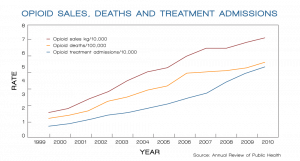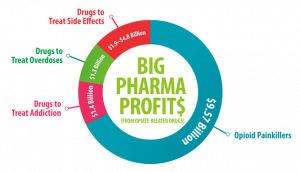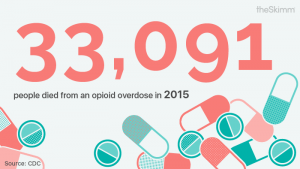https://www.youtube.com/watch?v=4AK0Ld1SR4w
By Katelyn Cross
https://www.thefix.com/sites/default/files/styles/article/public/movantik%20ad%20mr%20opioid.jpgIntroduction
Here is a photo of a women holding her “baggage” in which it is symbolic for her constipation symptoms. Next to her, is her solution—an opioid awaiting to “cure” her constipation and release her “baggage.” This is an ad aired by the NFL, portraying a cartoon advertisement of opioids—a prescription painkiller that is currently marked as an epidemic crisis throughout our country. I am interested in researching opioids because it is a common drug prescribed when going to the doctor, and is used in medical procedures through Anastasia as well as to release high amounts of pain as mentioned. The ad was released during the 2016 Super Bowl, and gave much offense to those who suffered from the opioid epidemic. The cartoon Disney-like opioid sits and mimics to be her best friend, and the one who will help her with her constipation problem.
History
The commercial was funded by a pharmaceutical research company called AstraZeneca, who specialize in various different research studies and topics, and work alongside scientists at “leading institutions to understand disease, identify potential new drugs and accelerate drug development” (Science In Our DNA n.d). It was also helped funded by Daiichi-Sanjyo, which is a global pharmaceutical company with corporate organs in Japan. The company aims to provide products and services in more than 20 countries around the world, “with more than 100 years of scientific expertise” they claim that their “company draws upon a rich legacy of innovation and a robust pipeline of promising new medicines to help patients” (Who We Are n.d). Ironic how companies who claim to raise awareness and improve the health and wellness of communities, are also contributing to dangerous epidemics.
Intended Audience
Not only are these companies contributing to funding to the opioid epidemic, but they are also spreading the access to the community. This ad was first aired during the Super Bowl of 2016. According to CNN, there was an average of “111.9 million TV viewers” (Game, T 2016). This number is extremely large, and many who watch the Super Bowl also take part into watching through all the commercials, or going back on YouTube the next day to watch them. In the picture I chose to display from the video particularly, it is targeting people with constipation—this is a common issue that affects lots of Americans, and it is safe to say many would do whatever they could to get rid of this issue (or baggage I should say). According to the article “Why Is The NFL Airing Ads Featuring A Cartoon Opioid Capsule” “Moreover, the cartoon take on the problem lessens the dangers of prescription painkillers by turning them into a Disney-like character. As opposed to Pixar’s Monsters, Inc., the Prescription, Inc., feeling of the commercial verges on the offensive” (Lavitt 2016). The feelings may be offensive to those who have suffered from opioids or know of people who have, but for those with little awareness, this commercial could be interpreted as cute and/or comical. Overall, I think the target audience is towards anyone who is watching. The general public is the open audience for the Super Bowl so the commercial was an aim towards any viewer, as well as people who specifically suffer with constipation, or get reeled in through animations, and advertisement techniques.
Active Ingredients
Opioids are painkillers wether in natural or synthetic form. They are commonly used in clinical practice and often prescribed as a way to cope with unbearable pain, and to assist during surgeries via Anastasia. According to the article “Basic opioid pharmacology: an update” “Morphine is commonly considered to be the archetypal opioid analgesic and the agent to which all other painkillers are compared” (Pathan and Williams 2016). Morphine is one of the most common opioids prescribed. The article further explains how there is evidence that suggests that the opium poppy, was cultivated for ingredients “as long ago as 3000 BC” (Pathan and Williams 2016). There is much to say about the poppy plant and many controversies raised from this. Morphine continued to be used widely and “In 1847 the chemical formula for morphine was deduced and this, coupled with the invention of the hypodermic needle in 1853, led to the more precise and widespread clinical use of morphine” (Pathan and Williams 2016). There are many active components that play a part in Opioid usage. There are naturally occurring alkaloids where are plant-periled amines that can be derived from it such as “morphine, codeine, papaverine, and thebaine” (Pathan and Williams 2016). However, morphine is known as the active component of the opium poppy, and chemicals can be manipulated in labs to create synthetic opioids that can be used through widespread medicine clinically, such as “diamorphine, dihydrocodeine, buprenorphine, nalbuphine, naloxone and oxycodone” (Pathan and Williams 2016). The active opioid, heroin, was once seen as safe to be prescribed even to children, however, once known of its addictive pulled from the market, people started realizing its effect and danger. According to the article “Prescription Opioid Narcotics and Heroin” “Today, OxyContin and Percocet are two of the frequently prescribed opioids used to treat pain. Both are narcotics containing the active ingredient oxycodone” (Prescription Opioid Narcotics and Heroin n.d.). This ingredient plays a part in the effects one feels when taking opioids. This ingredient is dangerous and influences physiological and mental health. The article, “What are Opiate Derivatives” states that, “According to Palomar College, opium belongs to a class of drugs known as narcotic analgesics” (What are Opiate Derivatives 2016). The drug ad did not mention any of these components, and in fact, left out every important thing about opioids that one should know. The ad was ultimately promoting opioids, making them look like the girls “best friend.” It showed no threat of addiction or any talk in what ingredients are in it, and this is very important to know. Instead, it should have taken the approach of “A pharmaceutical company just released this drug and these are the reasons you should not take it…” An approach to give reasonings towards preventing opioids would be the best because it would show people why they should avoid taking them and educate them on how they can be safe if a doctor were to prescribe.
Advertising Techniques
There was multiple advertisement techniques used in the commercial. Visual Imagery seemed to be the biggest as the animated opioid capsule was present as the woman’s best friend, comforting her through her constipation, and releasing her baggage, walking along side her throughout her time of discomfort. It also uses attention grabbers to show and make the opioid seem exciting, and being there for the woman the whole time, it aimed to keep peoples attention. It also uses statistics/facts to back up what is going on inside of the body, by showing the inside of someones stomach and having a physician demonstrate the affect and anatomy. This advertisement technique was aimed to give credibility. It also uses the power of words, such as labeling the women’s suitcase as “baggage” and the capsule “opioid” giving meaning to the objects and bringing them into context to real in viewers. It also uses lots of imagery throughout the video and even shows the woman and the capsule being painted of by an artist in a park. It also uses voice, to speak to the listener the whole time as the animation is occurring. All of these aspects play apart into reeling the viewer in and manipulating their mind through advertisement. Products and services have more credibility when backed up by facts, providing imagery to keep the audience interested, bringing objects “to life” as well as giving them meaning. The advertisement does not mention the negative affects of opioids or tries to make them seem bad, but instead, glorifies them in a way to make them look like the woman’s best friend.
Overall Opinion
My overall opinion on this drug is that it is very dangerous. If needed to take for medical purposes, such as surgery guidance via anesthesia, or strong pain killers to ease post surgery or other serious pain—one should be aware and educated of the risks involved, and the addiction that can take place if not taken under the supervision of a physician, or taken in larger quantities, or more frequently, than prescription ally recommended. According to the PBS article “CDC: Opioid painkillers shouldn’t be first choice for chronic pain” the CDC’s National Center for Injury Prevention and Control states that ““Management of chronic pain is an art and a science. The science of opioids for chronic pain is clear — for the vast majority of patients, the known, serious, and too-often fatal risks far outweigh the unproven and transient benefits” (Silverman 2016). Specifically, the drugs well known negative effects and risks outweigh the little known positive benefits, at learn for long term. Overall, I would not recommend this drug to any family or friend, or anyone for that matter unless prescribed by a physician. In my opinion, opioids should not be anyones first choice to deal with pain, unless they ultimately have no other option. To put things in perspective on why Opioid drugs are an issue, The PBS article further states that, “Every day, more than 40 Americans die from overdoses of opioid painkillers, according to the CDC. And each year, 2 million people abuse or misuse the drugs” (Silverman 2016). Opioid addiction is a big problem and this explains the epidemic here in the United States—physicians are continuously prescribing patients and while sometimes this is needed, opioids should not be seen as a first choice, but instead a last.
Sources:
Game, T. (2016, February 8). Super Bowl 50 audience is third largest in TV history. Retrieved November 15, 2017, from http://money.cnn.com/2016/02/08/media/super-bowl-50-ratings/index.html
Lavitt, John (2016, November 11). Why Is The NFL Airing Ads Featuring A Cartoon Opioid Capsule? Retrieved November 15, 2017, from https://www.thefix.com/why-nfl-airing-ads-featuring-cartoon-opioid-capsule
Pathan, H., & Williams, J. (2012, February). Basic opioid pharmacology: an update. Retrieved November 15, 2017, from https://www.ncbi.nlm.nih.gov/pmc/articles/PMC4590096/
Science in our DNA. (n.d.). Retrieved November 15, 2017, from https://www.astrazeneca.com/our-science.html
Prescription Opioid Narcotics and Heroin. (n.d.). Retrieved November 15, 2017, from http://www.rxreform.org/prescription-opioids/similarities-to-heroin/
Silverman, S. E. (2016, March 15). CDC: Opioid painkillers shouldn’t be first choice for chronic pain. Retrieved November 15, 2017, from https://www.pbs.org/newshour/health/cdc-opioid-painkillers-shouldnt-be-first-choice-for-chronic-pain
What are Opiate Derivatives? (2016, April 06). Retrieved November 15, 2017, from http://www.opium.org/what-are-opiate-derivatives.html
Who We Are. (n.d.). Retrieved November 15, 2017, from http://www.daiichisankyo.com/about_us/who_we_are/index.html






